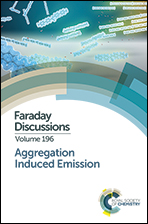Ionic complex of a rhodamine dye with aggregation-induced emission properties
Abstract
An AIE-active rhodamine based luminogen was prepared via a complexation reaction between non-emissive rhodamine hydrazide (RdH) and bulky camphorsulfonic acid (CSA). Besides acting to open the spirolactam ring of RdH, CSA also imposes a rotational restriction on the resultant ionic complex, RdH(CSA)x. Without CSA, the analogous complex RdH(HCl)3 is a luminogen with aggregation-caused quenching (ACQ) properties. The ionic bonds of RdH(CSA)3 are sensitive to several external stimuli and therefore it is a luminescent sensor for metal ions, organic amines and the blood protein bovine serum albumin (BSA). Besides being a sensor for BSA, the ionic RdH(CSA)3 is also a denaturant capable of uncoiling the peptide chain of BSA.
- This article is part of the themed collection: Aggregation Induced Emission

 Please wait while we load your content...
Please wait while we load your content...